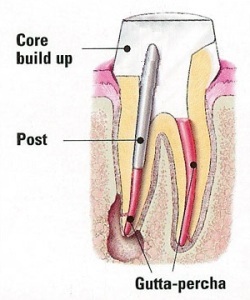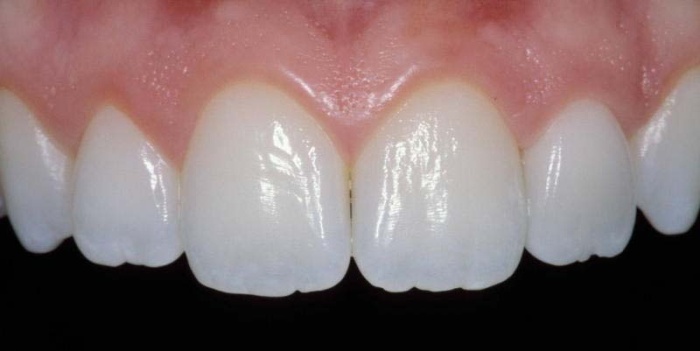Dear Dr. Hall,
I started off looking for information on teeth too white and then found this ask a dentist link so I thought I’d ask a different question that has been on my mind.
I have an eye tooth that had a root canal done on it perhaps 40 years ago. It has been suggested to me to have it capped to prevent it from breaking. What do you think? Thanks!
– Holly from Cleveland
We thank our advertisers who help fund this site.
Holly,
Thanks for your question. It’s the type of question I enjoy because it’s one where political correctness gives you one answer but science gives you a different answer.
A root canal treatment makes a tooth more brittle and more susceptible to breaking. And the easy answer is to just crown every tooth with a root canal. The insurance will pay for it, after all, and dentists like doing crowns much more than fillings because they’re much more profitable.
But there is a fundamentally different type of stress on a front tooth from the stress on a back tooth. Molars have four cusps, and the stress on a molar tends to push those cusps apart. So almost all fractures of molars are splits of one type or another. The same is largely true of premolars that have two cusps. Molars and premolars also are designed for grinding, where front teeth are designed for biting and tearing.
The potentially damaging stress on a front tooth, however, is almost entirely a shearing stress. The canine tooth (eye tooth), in particular, is subject to strong horizontal stresses. In fact, it is supposed to absorb most of the horizontal stresses to keep them from affecting the back teeth—a function called canine protection. This is why it has the longest root. When you grind your teeth side to side, it is usually the canine tooth that, by its slope, forces your back teeth apart and helps relieve the sideways stresses on those back teeth. The other front teeth take the stress of what is called anterior guidance—when you slide your lower jaw forward you do so against the inside surfaces of the upper front teeth. While this isn’t as great as the stresses on a canine tooth, they are significant stresses and are again horizontal.
Protecting a Root Canal Tooth from Fracture
So how do you protect a root canal tooth from fracture? For a back tooth, the answer is clear. A crown or onlay covering the chewing surface will absorb the vertical stresses and prevent splitting of the tooth.
But for a front tooth, the traditional, politically correct answer of crown every tooth with a root canal will actually weaken the tooth against its most seriously stresses.

Cross section of a front tooth with a crown
Read the story of Amber from Oregon who wrote to me several years ago, whose dentist told her she needed to have crowns on her three front teeth with root canals. Two weeks after putting the crowns on, one front tooth broke off at the gumline.
Well, some dentists may say, we can prevent that horizontal fracture by putting a titanium post down through the middle of the tooth. But, while a stiff post will help prevent fracture at the neck of the tooth, research has shown that it will transfer stress to the tip of the post, deep in the tooth, and will increase the likelihood of a vertical root fracture.
No, a crown on a front tooth with a root canal isn’t needed to protect the tooth against fracture, unless there is a lot of tooth structure already missing due to decay or pre-existing fracture. A crown may be needed, however, for aesthetic reasons, because a tooth with a root canal treatment can turn dark.
Here is my recommendation for treating a front tooth with a root canal treatment, assuming there is a great deal of healthy tooth structure remaining. First, I would clean out the inside part of the crown of the tooth—the visible part of the tooth—from all root canal filling materials and cement. These filling materials are the major source of darkening of a tooth after root canal treatment. Then I would cement in a white fiberglass post to help strengthen the tooth. The fiberglass post, since it flexes, will add resistance against horizontal fracture without transferring stress to deep in the root of the tooth. Then I would fill in all of the rest of the missing tooth structure with a strong composite material. From my experience, cleaning out all of the root canal filling material will delay the darkening of the tooth several years. When the tooth begins to turn dark, I would veneer the tooth with porcelain.
I hope this is helpful.
– Dr. Hall
Do you have a comment or anything else to add? We’d love to hear from you. Enter your comment below.
Click here to ask Dr. Hall a question of your own.
About David A. Hall
Dr. David A. Hall was one of the first 40 accredited cosmetic dentists in the world. He practiced cosmetic dentistry in Iowa, and in 1990 earned his accreditation with the American Academy of Cosmetic Dentistry. He is now president of Infinity Dental Web, a company in Mesa, Arizona that does advanced internet marketing for dentists.



 In this first photograph, some of the root canal filling material has been removed and a fiberglass post is fitted into the canal. The post needs to go deeply into the tooth, but not so far as to require removal of all of the root canal filling material. About 2/3 of the length of the tooth would be good.
In this first photograph, some of the root canal filling material has been removed and a fiberglass post is fitted into the canal. The post needs to go deeply into the tooth, but not so far as to require removal of all of the root canal filling material. About 2/3 of the length of the tooth would be good. Then the post is bonded into the canal and a core material is built up. Composite is usually used for both the bonding of the post into the canal and the core. That composite is then shaped into a conventional crown preparation as shown here.
Then the post is bonded into the canal and a core material is built up. Composite is usually used for both the bonding of the post into the canal and the core. That composite is then shaped into a conventional crown preparation as shown here.
 This isn’t Vance, but is a photo of another patient who has had a root canal treatment on a front tooth and a composite repair, similar to what Vance would have had. The composite covers about 1/3 of the tooth, consisting of the lower left corner as we are looking at it. You can see that the composite, while it is lighter than the rest of the tooth, is darker than the adjacent tooth. So the composite has discolored some, and the tooth has discolored more.
This isn’t Vance, but is a photo of another patient who has had a root canal treatment on a front tooth and a composite repair, similar to what Vance would have had. The composite covers about 1/3 of the tooth, consisting of the lower left corner as we are looking at it. You can see that the composite, while it is lighter than the rest of the tooth, is darker than the adjacent tooth. So the composite has discolored some, and the tooth has discolored more.